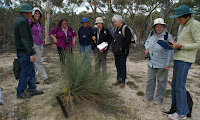Staff at the Wheatbelt NRM office were somewhat surprised this week when Lynette, a landholder from Bullaring, rang to find out what to do with a Red-tailed Phascogale she had found at her house!
Unfortunately it was deceased, but it is still a great find, showing that this charasmatic native critter is still around the Corrigin/Bullaring area.
 |
| Red-tailed Phascogale (Phascogale calura) found near Corrigin |
Lynette had seen them before at her property in Bullaring, but this time she decided to speak with Wheatbelt NRM’s Regional Landcare
Facilitator Mick Davis, who encouraged Lynette to send in the above photo and then contacted the WA Museum for more information.
They prefer woodland habitat with dense pockets of sheoak thickets surrounding old white gum trees to use as nesting sites. However they also occur in mallee scrub and will use letterboxes and hous roof cavities as alternative nesting sites.
 | |
| Distribution map for the Red-Tailed Phascogale. Dark blue shows current distribution, orange previous distribution and light blue and black indicates fossil records |
WA Museum Techincal Officer of Terrestrial Zoology (Vertebrates)
Claire Stevenson was very excited by Lynette’s find.
“We haven’t had a Red-tailed Phascogale specimen at the
Museum since 2007” she said, explaining that this record in near the edge of
this species’ known range. Upon closer inspection of local data it was found that this species was right on the edge of it's know distribution.
The (frozen) specimen will now be sent to the WA Museum – where it will be properly preserved and added to the states collection, adding to the wider communities'
knowledge and understanding of this unique species.
If you have seen these critters near you place or in your
travels, let Wheatbelt NRM know by calling 089 670 3110 or emailing info@wheatbeltnrm.org.au
For more information on recovery actions for the Red-tailed
Phascogale see the draft recovery plan on Wheatbelt NRM’s webpage.











